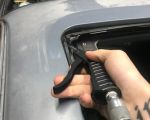As someone who has faced electrical failures in my home and car, I can confidently say that understanding how to troubleshoot and resolve electrical issues is an invaluable skill. From flickering lights to a dead car battery, electrical problems can be frustrating and even a bit intimidating. However, with a bit of knowledge and the right tools, many electrical failures can be solved quickly and safely. I’ve encountered various electrical issues over the years, and I’ve learned a lot about how to identify the cause of the problem and the steps to fix it. In this article, I’ll walk you through how to troubleshoot and solve electrical failures, whether they’re in your home or car.

Craig's Auto Repair
11037 Stranwood Ave, Mission Hills, CA 91345, USA
1. Understanding the Basics of Electrical Systems
The first step in solving any electrical failure is to understand the basics of how electrical systems work. Whether it’s the wiring in your house or the electrical components in your car, all electrical systems rely on a simple flow of current to power devices and appliances. When something goes wrong, the flow of electricity is disrupted. This can happen due to faulty wiring, blown fuses, or damaged components.
In my experience, understanding the layout and function of an electrical system can help you pinpoint the problem more effectively. For example, I once had an issue where the lights in my living room kept flickering. After some investigation, I discovered that a loose connection in the switch was causing an intermittent flow of electricity. If you’re dealing with an electrical failure, always take time to learn the basic workings of the system in question. This knowledge will give you a clearer idea of where the issue might be.
2. Troubleshooting Electrical Failures in the Home
Electrical failures in the home can range from minor inconveniences, like a tripped circuit breaker, to more serious problems, like a complete power outage. Over the years, I’ve encountered various home electrical failures, and I’ve learned how to troubleshoot many of them. Here’s a step-by-step guide on how to address some of the most common electrical issues at home:
2.1 Flickering Lights
Flickering lights can be annoying and often indicate an underlying issue. One time, the lights in my living room kept flickering, and at first, I thought it was just a simple bulb issue. However, after replacing the bulbs, the flickering continued. Here’s how I tackled the problem:
- Check the bulbs: Ensure the lightbulbs are correctly fitted and in good condition.
- Inspect the switches: A loose or faulty light switch can cause flickering. Tighten or replace the switch if necessary.
- Examine the wiring: If the bulbs and switches are fine, the issue may lie within the wiring, which should be inspected by a licensed electrician.
2.2 Tripped Circuit Breaker
One of the most common electrical problems in the home is a tripped circuit breaker. This happened to me during a power surge after using too many high-power appliances at once. Here’s how to resolve it:
- Locate the breaker panel: Find the circuit breaker box in your home.
- Identify the tripped breaker: A tripped breaker will be in the "off" position or be clearly labeled as tripped.
- Reset the breaker: Flip the tripped breaker back to the "on" position. If it trips again, it could indicate an overload or a wiring issue, and you should consult an electrician.
2.3 Dead Outlets
Dead outlets are another frustrating electrical failure I’ve encountered. One time, my kitchen outlet stopped working, and I wasn’t sure if the outlet itself was the problem or if it was a larger issue with the electrical system. Here’s how to troubleshoot dead outlets:
- Test with a multimeter: A multimeter can help you test if the outlet is receiving power.
- Check the GFCI outlets: If the outlet is part of a GFCI (Ground Fault Circuit Interrupter) circuit, check if the reset button needs to be pressed.
- Inspect the wiring: If the outlet still isn’t working, the wiring behind the outlet may be faulty and require professional inspection and repair.
3. Solving Electrical Failures in Your Car
In addition to home electrical issues, I’ve also dealt with electrical failures in my car. From a dead battery to malfunctioning lights, car electrical problems can often be easily diagnosed and fixed. However, some issues require more advanced troubleshooting. Here’s how I address common car electrical failures:
3.1 Dead Car Battery
A dead battery is one of the most common car electrical issues. I’ve found myself stranded a few times due to a dead battery, but I learned how to resolve the issue quickly. Here’s the process:
- Check the battery connections: Loose or corroded battery terminals can prevent the car from starting. Clean the terminals and tighten the connections if necessary.
- Jump-start the car: If the battery is completely drained, you can jump-start the car using jumper cables and another vehicle. I always keep a set of jumper cables in my car for emergencies.
- Replace the battery: If the car still won’t start after a jump, it may be time to replace the battery. Most auto parts stores can test the battery to determine if it’s still functional.
3.2 Malfunctioning Car Lights
Another common car electrical issue is malfunctioning headlights or interior lights. A few years ago, I noticed my headlights were flickering on and off. Here’s how I solved the problem:
- Check the bulbs: Sometimes, the issue is simply a burned-out bulb. Replace any faulty bulbs to see if that solves the problem.
- Inspect the fuses: A blown fuse can cause lights to malfunction. Check the fuse box and replace any blown fuses.
- Examine the wiring: If the problem persists, there may be an issue with the wiring or the switch, which would require a professional mechanic to repair.
4. When to Call a Professional
While many electrical failures can be solved with basic troubleshooting, there are times when it’s necessary to call a professional. For example, if you notice burning smells, sparks, or exposed wires, it’s essential to seek professional help immediately. I’ve had moments when I could’ve handled the problem myself, but I knew the risk of further damage or injury wasn’t worth it. Calling in a licensed electrician or mechanic can save you time, money, and stress in the long run.
If you’re unsure about the severity of the issue or don’t feel comfortable making the repair yourself, don’t hesitate to contact a professional. In some cases, electrical problems can lead to fires or other hazardous situations, so it’s better to be safe than sorry.
For car-related electrical issues, I recommend visiting a professional auto repair service. In case of towing needs or emergency roadside assistance, you can rely on trusted services like Rescue & Towing for fast, reliable help.




























